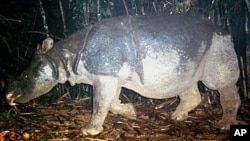The fate of one of Vietnam’s most important national parks is hanging in the balance this week as the government decides whether to back a plan to build two hydropower dams in the area.
Rare wildife sanctuary
Wedged between swathes of paddy fields and only 161 kilometers north east from the country’s biggest city, Ho Chi Minh, Cat Tien park provides a rare sanctuary for native wildlife.
In nearly 80,000 hectares of lush lowland forest and expansive wetlands, rare animals like the duoc langur and the pigmy slow loris make a home, alongside 100 other endangered mammals.
But much of that could change if the government approves plans to build two hydropower dams on the Dong Nai River, which runs through the park.
The river is the second largest in south Vietnam.
Environment impact
Director of the park, Tran Van Thanh, warns there will be a serious impact on biodiversity.
“If they build the dam, many trucks will be used for building and that means more people will come to the area to work," he said. "They will destroy the forest and use forest products. They will even use dynamite to dig the material. They will make noise and build the road. They will have a lot of impact on wildlife."
If the project is approved, work on Dong Nai 6 and 6A will begin in 2015.
Investors say the 241 megawatt dams will have minimal impact on the environment. A total of 372 hectares of forest will be affected, straddling four provinces, but only 137 hectares of that is in Cat Tien Park.
Despite the assurances, Duong Trung Quoc, National Assembly representative for Dong Nai province, says he is against the move.
Quoc says local people do not want the dams and it is his job to represent their views. However, professionals and local media remain divided over the issue so all research should be presented clearly.
In a statement released in September, the conservation group the Vietnam Association for Conservation of the Nature and Environment caused a stir in the local media by supporting of the plan.
The group said the dams would not be built in the center of the park and thus would not damage the core biodiversity area.
Park director Thanh disagrees. He argues that with some 200,000 people currently living around the park, human encroachment has already reached critical levels. Any more pressure, he says, would be devastating.
“With more people it is more difficult to protect this area. Now every year we have about 300-500 cases of people taking forest products. Every year we collect a lot of traps and guns. For example, last year we collected about 25,000 traps and around 20 guns from hunters,” Thanh stated.
Expanding eneregy, economic growth
Others argue Vietnam needs the energy. With an ever expanding population and economic growth, Vietnam’s power consumption is forecast to double in the next 10 years. Demand for electricity alone is increasing by about 15 percent every year.
Jeremy Carew-Reid, director of the Center for Environmental Management, says the dam proposal in Dong Nai province reflects what is happening throughout Vietnam and the Mekong region.
Carew-Reid says a total transformation in the aquatic environment is taking place due to the pace and scale of hydro development.
He says the problem is this is happening with little effective assessment, planning or management, and the impacts on the natural and cultural diversity of the region are very significant.
Vo Van Chanh, deputy director of the Department of Natural Resources and Environment in Dong Nai province, says authorities are aware of the different arguments surrounding the dam.
Chanh says the provincial People’s Committee asked the department to organize a conference last week to discuss the plan. After hearing both negative and positive arguments, the department is now considering the best course of action to take.
He says he has not yet decided which side to take, but the department is in the process of writing up a plan aimed at mitigating the negative impacts of the dams.
Extinct species
The status of many of Vietnam’s endangered species is already critical, with a rampant black market trade in listed animals for traditional medicine and the harvesting of forest products by local communities.
Just last week the World Wide Fund for Nature, together with officials from Cat Tien, announced that one of the park’s most famous species - the Javan rhino - was now extinct. The last known animal to survive in Vietnam was found dead last year with a bullet in its leg and its horn sawn off.
Some fear if developers get their way and the dams are built, many more endangered species in Vietnam will meet the fate of the Javan rhino.








